ABSTRACT
Global food security is a critical issue, further intensified by population growth, climate change, and the depletion of natural resources. Sustainable agriculture offers a promising solution particularly through the enhancement of nutrient recovery for fertilizer production. This study examines the intersection of sustainable agriculture and global food security, focusing on the vital role of nutrient recovery in improving soil health, boosting crop yields, and minimizing environmental impacts. This paper provides an overview of the challenges to global food security and underscores the need for sustainable agricultural practices to address these challenges. It emphasizes the potential of recovering nutrients from waste streams, such as food waste, and wastewater to produce fertilizers. Key findings suggest that nutrient recovery could reduce reliance on synthetic fertilizers by up to 30%, improve soil nutrient content by 20-40%, and increase crop yields by 10-15%. These results highlight the significant benefits of incorporating nutrient recovery technologies into agricultural systems.
Keywords: Fertilizer production, Food security; Nutrient recovery; Sustainable agriculture; Organic waste
INTRODUCTION
The global food crisis is currently one of the urgent threats facing the world. A key challenge today is how to feed a rapidly growing population while ensuring a sustainable resource base to meet their needs. The world’s population is projected to reach 9.7 billion by 2050 (Sniatala et al., 2022), a one-third of increase from the total population in 2010. To ensure food security amid climate change, which threatens agricultural production systems, food production must increase by 70% in 2050 (Figure 1). While global food production has tripled over the past several decades, rising from 3.3 million metric tons in 1970 to 10 million metric tons today (Kurniawan et al., 2021a), this growth has been driven by population growth and increased consumption.
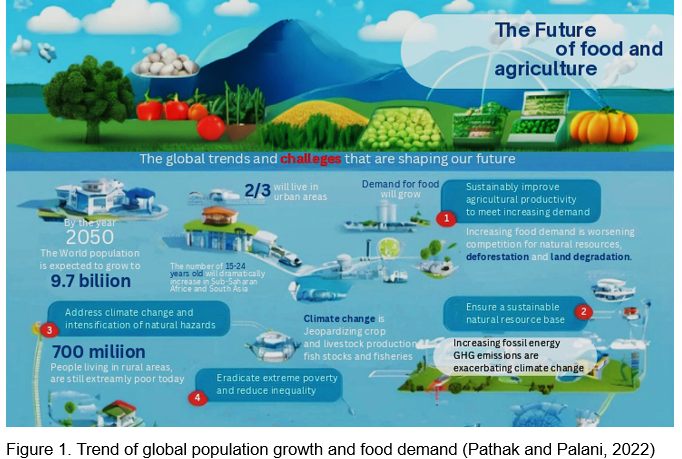
With the global population expected to reach 10 billion by 2050, food production must increase significantly to meet demand. The rapid population growth over recent decades has heightened awareness of food security issues. Although food systems are producing more food and calories as ever before, global crop diversity and dietary variety are steadily declining. This trend has made both the environment and food production more vulnerable to climatic shocks, with adverse effects on human nutrition and health. Rising food and fuel prices are also making healthy diets less affordable, particularly for marginalized communities. Furthermore, rapid urbanization, population growth, and rising incomes in emerging economies are reshaping both local and global food systems, leading to increased demand for affordable and safe food in urban areas (Kurniawan et al., 2021b). Addressing this dual challenge requires innovative strategies to sustain food production without further depleting natural resources.
In response to these challenges, there is growing emphasis on enhancing nutrient recovery from organic waste streams and incorporating recovered nutrients into fertilizer production. Fertilizers play a pivotal role in modern agriculture, boosting crop yields by replenishing essential nutrients such as nitrogen (N), phosphorus (P), and potassium (K). However, conventional fertilizer production faces critical challenges. A circular bioeconomy could provide a pathway of fertilizer production for developing sustainable agriculture and food systems through nutrient recovery. This approach involves extracting valuable nutrients from agricultural residues, food waste, and wastewater, and transforming them into effective, eco-friendly fertilizers (Figure 2). Such practices not only address waste management challenges but also promote a biocircular economy, where nutrients are recycled and reused, reducing reliance on finite natural resources (Kurniawan et al., 2022).
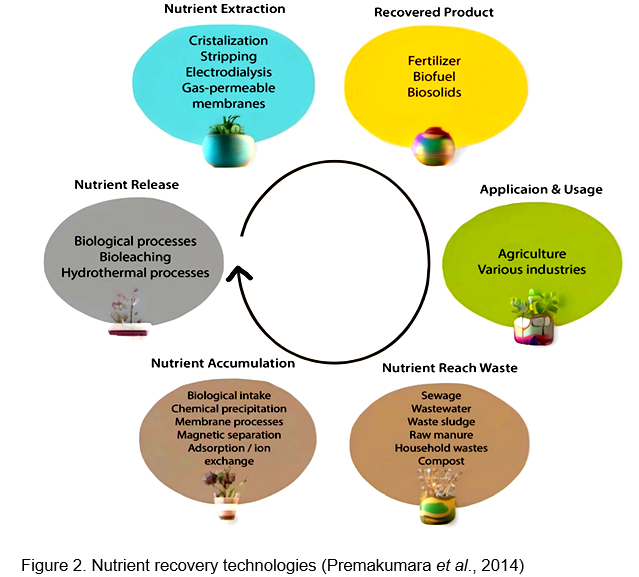
Phosphorus, for example, is derived primarily from phosphate rock, a non-renewable resource concentrated in a few countries, raising concerns over long-term availability and geopolitical risks. Simultaneously, nitrogen fertilizer production is heavily dependent on energy-intensive processes that contribute to greenhouse gas emissions. These factors highlight the urgent need for sustainable alternatives to ensure nutrient availability for future generations.
Ironically, while global agriculture grapples with nutrient scarcity, vast amounts of nutrients are lost each year through organic waste streams. Food waste, agricultural residues, sewage sludge, and even cigarette butts contain recoverable quantities of N, P, and K, yet much of this waste ends up in landfills or incinerators, contributing to pollution and greenhouse gas emissions. The mismanagement of organic waste represents a missed opportunity to recover valuable resources and mitigate environmental harm.
Currently, as the global food markets are growing swiftly, driven by the demand for bio-based supplements and therapeutic products, such high demand has posed challenges in the availability of the bioresources and downstream processing technology to produce high quality products (Figure 3). The alarming situation related to global food supply chains and wastes calls for urgent solutions for bioresource recovery to close the loops, creating a circular bioeconomy.
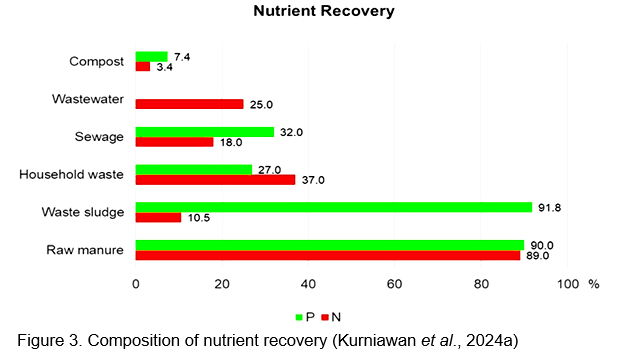
In this context, waste-to-fertilizer technologies have emerged as a promising solution to bridge the gap between nutrient demand and supply. These technologies leverage advanced processes, such as anaerobic digestion, biochar production, and nutrient extraction, to recover nutrients from waste materials and convert them into high-quality fertilizers. Beyond their environmental benefits, these methods align with circular economy principles, transforming waste into a resource and reducing dependence on non-renewable inputs.
It is expected that the world can make a key difference in this global environmental change through circular bioeconomy in the form of waste-to-fertilizer technologies. To exercise climate leadership, it is important for cities to promote transition that provides leverage to curb the consumption of raw material from natural resources through circular economy of materials disposed in landfills (Figure 4) ( Osman et al., 2025; Panda et al., 2024; Pathak et al., 2022). Recovering nutrients embedded in wastewater is an opportunity to transition to biocircular economy and contribute to sustainable agriculture and food systems.
One of the most pressing consequences of this geopolitical crisis is the severe shortage of fertilizers, a critical input for modern agriculture. This shortage threatens to exacerbate existing challenges in global food production, potentially leading to a looming food security crisis. The fertilizer shortage caused by the Russian-Ukraine war has far-reaching implications for global food security. The disruption in fertilizer supply contributes to rising food prices, which can strain household budgets and increase food insecurity in low-income and developing regions. Declining crop yields and higher food prices can lead to increased hunger and malnutrition in vulnerable populations already at risk. The interconnected nature of global food supply chains results in disruptions in one region, leading to cascading effects worldwide. Countries dependent on imports of fertilizers and food may therefore face shortages and price volatility.
To mitigate the impact of fertilizer shortages and ensure global food security, several strategies are essential. Reducing reliance on a few major fertilizer producers and exploring alternative sources can help stabilize supply chains and reduce vulnerability to geopolitical disruptions. Encouraging the adoption of sustainable agriculture practices, such as nutrient recycling and organic farming, can reduce dependency on synthetic fertilizers and improve resilience.
Nutrient recovery optimizes the use of available resources by recycling nutrients from food waste, livestock manure, and liquid wastewater from landfill (Figure 5). This reduces dependency on non-renewable resources, such as phosphates and fossil fuels, and promotes a circular economy in agriculture. Nutrient recovery not only provides an alternative source of fertilizers but also improves soil health by restoring essential nutrients. Healthy soils are more productive and resilient, leading to better crop performance and long-term sustainability of agricultural systems. Implementing nutrient recovery technologies can create economic opportunities, particularly in rural and agricultural communities. This approach can also make fertilizers more accessible and affordable for smallholder farmers, promoting more equitable and inclusive agricultural development.
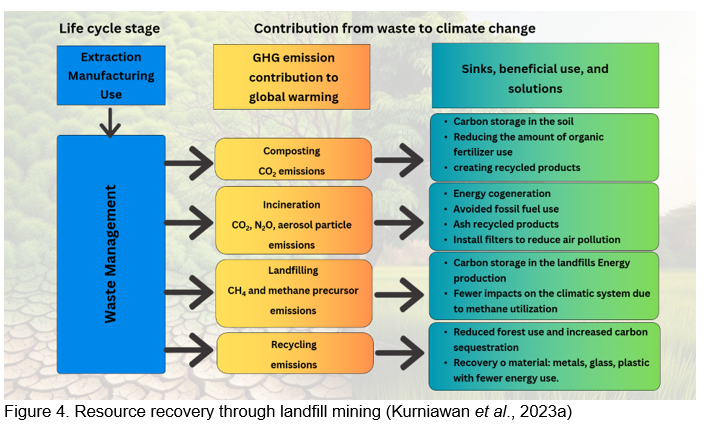
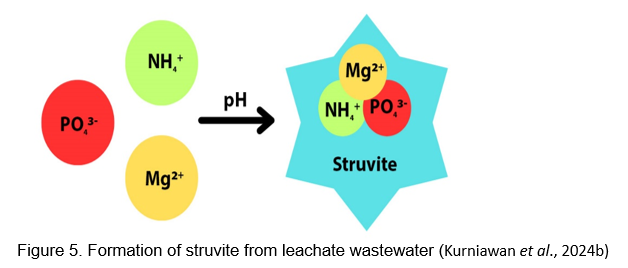
Sustainable nutrient recovery practices also improve soil health by replenishing essential nutrients, leading to better crop yields and more resilient agricultural systems. This is crucial for long-term food production and the sustainability of farming practices. By enhancing nutrient recovery from waste streams, this work advocates for more sustainable practices that reduce the environmental footprint of agriculture, helping to conserve natural resources and mitigate climate change.
To reflect its novelty, this work explores the pivotal role of nutrient recovery in advancing sustainable agriculture and enhancing global food security. At the same time, it examines practices for recovering nutrients and their application in agriculture. This work presents a comprehensive framework that links nutrient recovery from various waste streams directly to global food security. While nutrient recovery and sustainable agriculture have been studied separately, this work uniquely integrates them, demonstrating how they can synergistically address food security challenges on a global scale. By addressing critical gaps in current waste management and nutrient recovery practices, this work offers a pathway to sustainable fertilizer production and contributes to global efforts to secure food for future generations.
The work also emphasizes the application of circular economy principles in agriculture by promoting the recycling of nutrients from food waste, livestock manure, and wastewater into fertilizers. This approach is innovative as it shifts the paradigm from linear resource use to a closed-loop system, reducing waste and enhancing resource efficiency in agriculture. The study also explores how sustainable agricultural practices through nutrient recovery can boost crop yields and ensure a stable food supply, making it crucial for global food security. The work aligns with the principles of a circular economy, where waste materials are repurposed and reintegrated into the production cycle. This reduces waste, conserves resources, and creates more sustainable agricultural practices.
The objectives of this study are to evaluate the effectiveness of nutrient recovery technologies, assess their potential benefits for soil fertility and crop yields, and explore their contributions to a more sustainable and resilient agricultural system. By highlighting key findings and advancements in nutrient recovery, this work aims to provide insights into how the practices can support global food security and drive the transition towards sustainable agricultural practices. Through a comprehensive review of current methods and their applications, the study offers recommendations for integrating nutrient recovery into agricultural systems and policy frameworks, contributing to a more sustainable and food-secure future.
By demonstrating the benefits of nutrient recovery, this work highlights the need for supportive policies and economic incentives to promote the practices, while underscoring the necessity of advancing waste-to-fertilizer technologies to address the interrelated challenges of food security, resource scarcity, and environmental sustainability. Through the innovative use of waste materials and cutting-edge adsorption techniques, the study provides a foundation for scalable and sustainable solutions to meet the nutrient demands of a growing global population. By focusing on nutrient recovery, this work supports the reduction of waste associated with conventional fertilizer production and use. This contributes to efforts to combat climate change, reduce GHG emission, and protect natural ecosystem.
KNOWLEDGE GAPS
Although this work addresses critical areas, there are still knowledge gaps that need to be explored to fully realize the potential of nutrient recovery and sustainable agriculture. While nutrient recovery is known to enhance soil fertility, there is limited long-term data on how these practices affect the overall soil health, biodiversity, and ecosystem services over extended periods. Therefore, longitudinal studies are needed to monitor the effects of nutrient recovery on soil microbial communities, soil structure, and ecosystem services such as water retention and carbon sequestration. Understanding the long-term impacts can refine nutrient recovery practices to maximize their benefits.
CONTRIBUTION TO UN SDGs
The work makes significant contributions to several United Nations Sustainable Development Goals (UN SDGs). The primary focus of the work is on enhancing global food security, which directly contributes to SDG#2 ‘Zero Hunger’. By promoting sustainable agriculture and nutrient recovery for fertilizer production, the work aims to increase agricultural productivity, improve soil health, and boost crop yields. This helps ensure a reliable food supply, particularly in regions facing food insecurity, ultimately working towards the goal of ending hunger and achieving food security.
The emphasis on nutrient recovery from waste streams aligns with SDG#12 ‘Responsible Consumption and Production’ by promoting sustainable consumption and production patterns. The work advocates for a circular economy in agriculture, where waste materials such as food waste, livestock manure, and wastewater are recycled into valuable fertilizers (Figure 6). By diverting waste from landfills and recovering nutrients, waste-to-fertilizer initiatives can reduce greenhouse gas emissions, alleviate nutrient pollution, and support resilient agricultural systems. This reduces waste, conserves resources, and promotes more efficient and responsible use of natural resources.
By reducing reliance on synthetic fertilizers, which are energy-intensive and contribute to GHG emissions, the work supports SDG#13 ‘Climate Action’. Nutrient recovery and sustainable agricultural practices help mitigate climate change by lowering the carbon footprint of food production and reducing environmental pollution. Additionally, healthier soils sequester more carbon, further contributing to climate action. Overall, this work contributes to UN SDGs by addressing food security, promoting sustainable resource management, mitigating climate change, protecting ecosystems, and fostering economic development through the advancement of sustainable agricultural practices.
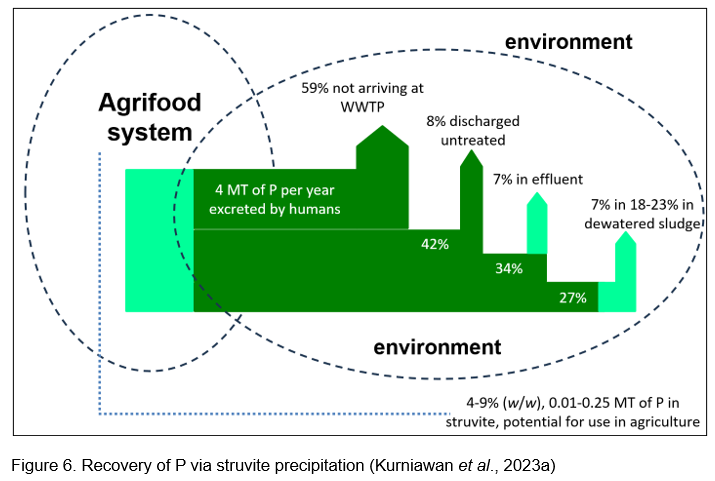
CASE STUDIES: TAKAKURA HOME COMPOSTING (THC) METHOD
THC, developed by Dr. Koji Takakura (Japan), is a method of composting organic waste in a controlled, simple, and effective manner. This method has significant contributions to agricultural farming as a fertilizer. THC produces high-quality compost rich in essential nutrients such as N, P, and K (Figure 7). These nutrients are crucial for plant growth and soil health. By incorporating this compost into the soil, farmers can enhance soil fertility and improve crop yields. The compost adds organic matter to the soil, which improves soil structure, water-holding capacity, and aeration. This helps create a favorable environment for root development and beneficial soil microorganisms.
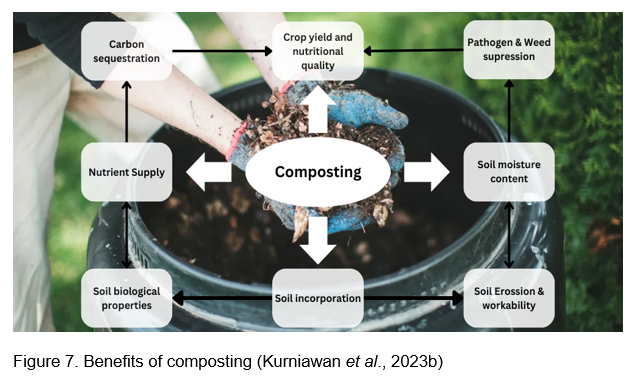
Takakura composting promotes the growth of beneficial microorganisms in the compost. When applied to the soil, these microorganisms enhance soil biological activity, which contributes to nutrient cycling and the overall health of the soil ecosystem. The compost can help suppress soil-borne diseases and pests by enhancing the microbial diversity and activity in the soil. Healthy soil with a balanced microbial community is more resilient to disease outbreaks. By using Takakura compost as a natural fertilizer, farmers can reduce their reliance on synthetic fertilizers. This not only cuts costs but also minimizes the environmental impacts associated with the production and application of chemical fertilizers. Incorporating compost into farming practices promotes sustainable fertility management. It helps close the nutrient loop by recycling organic waste into valuable soil amendments, reducing the need for external inputs.
The organic matter in Takakura compost helps improve soil structure by promoting the formation of soil aggregates. Better soil structure enhances root penetration and reduces soil compaction. Compost increases the soil’s ability to retain water, which is particularly beneficial during dry periods. Improved water retention helps maintain consistent soil moisture levels, reducing the need for frequent irrigation.
THC provides an effective solution for managing organic waste at the household level. By recycling kitchen scraps, garden waste, and other organic materials, it reduces the volume of waste sent to landfills. The composting process produces fewer greenhouse gases compared to landfill decomposition. By turning organic waste into compost, the method helps mitigate climate change by reducing methane emissions.
The Takakura composting method is simple and cost-effective, making it accessible for small-scale and local farmers. It allows them to produce high-quality compost with minimal investment, supporting local food production. In community and urban farming settings, Takakura composting can be used to create nutrient-rich soil amendments for shared garden plots and urban agriculture projects, enhancing food security and community resilience.
The use of Takakura composting in agriculture raises awareness about sustainable waste management and organic farming practices. It serves as an educational tool for promoting environmental stewardship and responsible resource use. Overall, THC contributes to agricultural farming by providing a nutrient-rich, organic fertilizer that enhances soil fertility and health, reduces reliance on synthetic fertilizers, improves soil structure and water retention, and supports sustainable waste management practices. Its simplicity and effectiveness make it a valuable tool for both small-scale and larger agricultural operations.
CASE STUDIES: BOKASHI HOME COMPOSITNG (BHC) METHOD
Bokashi home composting is an innovative approach to managing household organic waste, drawing from traditional Japanese practices. Unlike conventional composting methods, which rely on the presence of oxygen to break down organic matter, Bokashi uses an anaerobic process, meaning it occurs in the absence of oxygen. This process leverages a special mix of microorganisms to ferment, rather than decompose, the waste (Figure 8).
The journey begins with the preparation of a Bokashi bin, an airtight container equipped with a spigot for draining liquid. The process also requires Bokashi bran, which is inoculated with beneficial microorganisms such as lactic acid bacteria, yeasts, and phototrophic bacteria. As organic waste, including vegetable scraps, coffee grounds, and even small amounts of meat or dairy, is added to the bin, it is layered with the Bokashi bran. This layering continues until the bin is full.
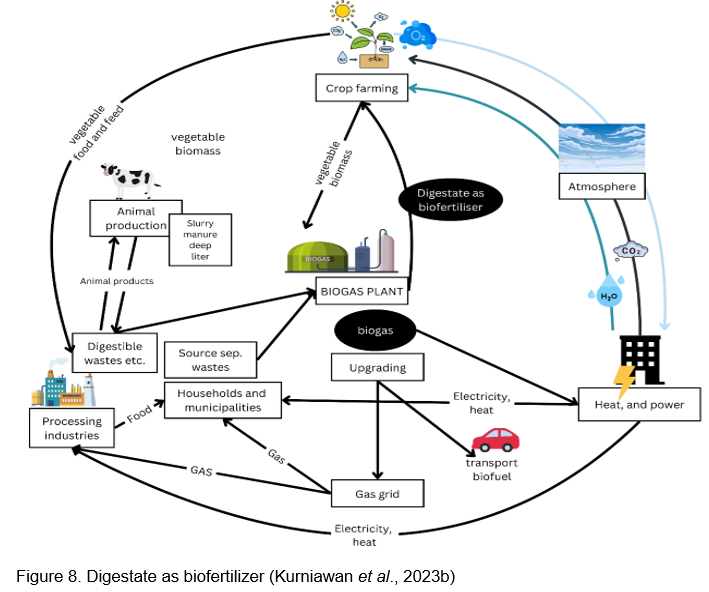
Once the bin is sealed, the fermentation phase begins. For approximately two weeks, the microorganisms work to ferment the waste in the oxygen-free environment, producing a pickled, semi-decomposed material. During this period, the bin is stored in a cool, dark place to maintain the right conditions for fermentation.
An interesting byproduct of this process is the liquid known as "Bokashi tea." This nutrient-rich liquid is drained regularly and can be diluted with water to serve as a powerful fertilizer or even as a natural drain cleaner. After the two-week fermentation, the contents of the Bokashi bin are ready for the final stage. The fermented material can be buried directly in the soil or added to a traditional compost pile, where it will decompose rapidly and enrich the soil.
Bokashi composting stands out for its versatility and efficiency. Unlike traditional composting, it can handle a broader range of organic waste, including items like meat and dairy that are typically avoided due to odor and pest concerns. Its space-efficient design makes it particularly suitable for urban environments, where space may be limited. Moreover, the process is relatively quick, and the airtight containers used in Bokashi composting help to eliminate any unpleasant odors.
One of the key benefits of this method is that it preserves more nutrients in the composted material, which can be extremely beneficial for soil health. This makes Bokashi composting an attractive option for those looking to reduce household waste and enrich their gardens, even in small urban settings.
In comparison to other methods, such as the Takakura Home Composting (THC) method, which relies on aerobic decomposition, Bokashi offers a more controlled and efficient process, albeit with the added step of acquiring or preparing Bokashi bran. The choice between these methods may depend on individual preferences and specific household needs.
BENEFITS OF THIS WORK
The expected results of the work encompass a range of outcomes aimed at improving food security, advancing sustainable agriculture, and promoting environmental sustainability. Development and optimization of technologies for more efficient recovery of nutrients from waste streams, such as agricultural residues, food waste, and wastewater lead to a higher quality and quantity of recovered nutrients available for use in fertilizers. Better management practices that minimize nutrient losses during fertilizer application result in more effective use of nutrients and improved crop productivity (Batool et al., 2023).
Application of recovered nutrients from sludge improves soil fertility by adding essential nutrients and organic matter (Figure 8). This will lead to better soil structure, water retention, and microbial activity. With improved soil conditions and more efficient nutrient use, farmers can expect increased crop yields and better quality produce. This contributes to enhanced food security and agricultural productivity.
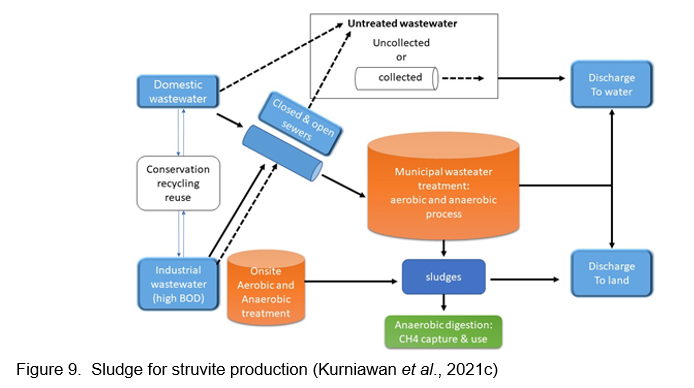
A shift towards using recovered nutrients will decrease the reliance on synthetic fertilizers, which are resource-intensive and environmentally taxing to produce. By minimizing the need for synthetic fertilizers and effectively managing organic waste, the work will contribute to reduced greenhouse gas emissions and lower environmental pollution. Farmers and agricultural producers may experience cost savings due to reduced expenditure on synthetic fertilizers and improved efficiency in nutrient use. Development and commercialization of nutrient recovery technologies can stimulate economic growth and create job opportunities in waste management and agricultural sectors (Kurniawan et al., 2023b).
SYNERGY AMONG TECHNOLOGICAL AND POLICY IMPLEMENTATION
Advancing global food security through sustainable agriculture while enhancing nutrient recovery for fertilizer production involves a multi-faceted approach that integrates technology, policy, education, and collaboration. To promote efficient nutrient recovery technologies, it is necessary to invest in research and development to improve nutrient recovery technologies, such as anaerobic digestion, composting, and nutrient extraction from wastewater, while focusing on making these technologies more efficient, cost-effective, and scalable.
It is crucial to implement pilot projects to test and showcase the effectiveness of nutrient recovery technologies in various agricultural settings. The demonstrations can help validate technologies and encourage broader adoption. To integrate nutrient recovery into agricultural practices, it is necessary to use precision agriculture techniques to optimize nutrient application, reduce waste, and improve the efficiency of recovered nutrients. Technologies like soil sensors and variable-rate application systems can enhance nutrient management.
Additionally, it is necessary to promote the integration of nutrient recovery within circular agricultural systems where organic waste, such as crop residues and manure, is recycled into valuable fertilizers, closing the nutrient loop. To enhance Soil Health and Fertility, it is vital to use recovered nutrients to enhance soil fertility and structure, which can lead to increased crop yields and resilience. Practices like cover cropping, reduced tillage, and organic amendments contribute to sustainable soil health. It is necessary to continuously monitor soil health and nutrient levels to adjust practices and ensure optimal use of recovered nutrients, maintaining soil fertility and preventing over-application.
By implementing these strategies, it is possible to advance global food security while enhancing nutrient recovery for fertilizer production. This integrated approach will contribute to sustainable agricultural practices, improved soil health, and a more resilient food system (Al-Hazmi et al., 2024).
NAVIGATING THE FUTURE: PROMOTING FOOD SECURITY THROUGH SUSTAINABLE AGRICULTURE
The journey towards enhancing global food security through sustainable agriculture, particularly via nutrient recovery for fertilizer production, represents a pivotal and multifaceted endeavor. To fully realize the potential of this work and ensure its lasting impact, several strategic pathways must be pursued.
Scaling up implementation is crucial for translating research into real-world benefits. Pilot programs are essential for testing nutrient recovery technologies in diverse agricultural settings, providing insights into their viability and effectiveness. By tailoring the solutions to regional contexts, those facing acute food security challenges, we can optimize their impact and foster broader adoption.
Enhancing research and development (R&D) will drive the innovation needed to advance nutrient recovery technologies. Investing in R&D to improve the efficiency, affordability, and environmental sustainability of these technologies is vital. Interdisciplinary research that integrates agronomy, environmental science, and economics will yield a more comprehensive understanding of nutrient recovery’s impacts and opportunities (Premakumara et al., 2014).
By pursuing these strategic pathways, we can advance the implementation of nutrient recovery in agriculture, ultimately contributing to global food security, environmental sustainability, and economic development. The collective effort of stakeholders across sectors is essential in realizing the full potential of this transformative work (Batool et al., 2024).
CONCLUSION
The challenges and opportunities in the fertilizer industry reflect broader global efforts to enhance sustainability and resilience in the global economy. This work highlights the complex interplay of geopolitics, decarbonization, and food security, underscoring the evolving geopolitical implications of these interconnected factors. This dynamic landscape calls for a research agenda that addresses the factors reshaping the industry. Whether green industrialization can offer a viable solution remains an intriguing question for the future. Understanding the complexities of the path forward is forging a new approach that both protects and ensures food security for future generations.
The study emphasizes the critical role of efficient nutrient recovery in achieving global food security and advancing sustainable agricultural practices. Through a comprehensive exploration of nutrient recovery technologies and their applications, the study offers insights and key findings that are essential for shaping future agricultural strategies.
The shift towards using recovered nutrients supports sustainable fertilizer production by reducing reliance on resource-intensive synthetic fertilizers. This transition contributes to a lower environmental footprint and supports circular economy principles. The economic advantages of using recovered nutrients include cost savings on synthetic fertilizers and potential economic growth in the nutrient recovery sector. Environmentally, the reduction in greenhouse gas emissions and improved waste management practices contribute to a more sustainable agricultural system.
This work emphasizes that effective nutrient recovery and management are crucial for enhancing global food security. By improving agricultural productivity and resilience, these practices address food security challenges and support the stability of food systems worldwide. The findings provide valuable evidence to inform policy development and regulatory frameworks, promoting the adoption of nutrient recovery practices. Additionally, the study highlights the need for increased education and awareness to facilitate the widespread implementation of sustainable practices.
Overall, this work presents a transformative approach to addressing critical challenges in agriculture and food security. The integration of advanced nutrient recovery technologies, coupled with improved soil management and sustainable practices, paves the way for a more resilient and efficient agricultural system. The key findings underscore the potential for significant economic, environmental, and social benefits, positioning nutrient recovery as a vital component in advancing global food security and promoting sustainable agricultural development.
REFERENCES
Al-Hazmi, H.E., Hassan, G.K., Kurniawan, T.A., Sniatala, B., Joseph, T.M., Majtacz, J., Piechota, G., Li, X., El-Ghary, F.A., Saeb, M.R., & Makinia, J. 2024. Technological solutions to landfill management: Contribution toward recovery of biomethane and carbon neutrality. J. Environ. Manage. 354, 120414. doi: 10.1016/j.jenvman.2024.120414
Batool, F., Kurniawan, T.A., Mohyuddin, A., Othman, M.H.D., Goh, H.H., Anouzla, A., & Chew, K.W. 2023. Fixed bed studies of landfill leachate treatment using chitosan-coated carbon composite. Water 15, 2263. doi: 10.3390/w15122263
Batool, F., Kurniawan, T.A., Mohyuddin, A., Othman, M.H.D., Aziz, F., Al-Hazmi, H., Goh, H.H., & Anouzla, A. 2024. Environmental impacts of food waste management technologies: A critical review of life cycle assessment (LCA) studies. Trend in Food Sci. Technol. 143, 104287. doi: 10.1016/j.tifs.2023.104287
Kurniawan, T.A., Oliveira, J.P., Gamaralalage, P.J.D., & Nagaishi, M. 2013. City-to-city level cooperation for generating urban co-benefits: The case of technological cooperation in the waste sector between Surabaya (Indonesia) and Kitakyushu (Japan). J. Clean. Prod. 58, 43–50. doi: 10.1016/j.jclepro.2013. 08.002.
Kurniawan, T.A., Avtar, R., Singh, D., Xue, W., Dzarfan Othman, M.H., Hwang, G.H., Iswanto, I., Albadarin, A.B., & Kern, A.O. 2021a. Reforming MSWM in Sukunan (Yogjakarta, Indonesia): A case-study of applying a zero-waste approach based on circular economy paradigm. J. Clean. Prod. 2020, 124775. doi:10.1016/j.jclepro.2020.124775.
Kurniawan, T.A., Singh, D., Avtar, R., Dzarfan Othman, M.H., Hwang, G.H., Albadarin, A.B., Rezakazemi, M., Setiadi, T., & Shirazian, S. 2021b. Resource recovery from landfill leachate: An experimental investigation and perspectives. Chemosphere 274, 129986. doi: 10.1016/ j.chemosphere.2021. 1299.
Kurniawan, T.A., Singh, D., Xue, W., Avtar, R., Othman, M.H.D., Hwang, G.H., Setiadi, T., Albadarin, A.B., & Shirazian, S. 2021c. Resource recovery toward sustainability through nutrient removal from landfill leachate. J. Environ. Manag. 2021, 287, 112265. doi: 10.1016/j.jenvman. 2021.112265.
Kurniawan, T.A., Liang, X., Singh, D., Othman, M.H.D., Goh, H.H., Gikas, P., Kern, A.O., Kusworo, T.D., & Shoqeir, J.A. 2022. Harnessing landfill gas (LFG) for electricity: A strategy to mitigate greenhouse gas emissions in Jakarta (Indonesia). J. Environ. Manag. 301, 113882. doi: 10.1016/j.jenvman. 2021.113882.
Kurniawan, T.A., Othman, M.H.D., Liang, X., Ayub, M., Goh, H.H., Kusworo, T.D.K., Mohyuddin, A., & Chew, K.W. 2023a. Microbial fuel cells (MFC): A potential game-changer in renewable energy development. Sustainability 4, 16847. doi: 10.3390/su142416847
Kurniawan, T.A., Othman, M.H.D., Liang, X., Goh, H.H., & Chew, K.W. 2023b. From liquid waste to mineral fertilizer: Recovery, recycle and reuse of high-value macro-nutrients from landfill leachate to contribute to circular economy, food security, and carbon neutrality. Proc. Saf. Environ. Prot. 170, 791-807. doi: 10.1016/j.psep.2022.12.068
Kurniawan, T.A., Othman, M.H.D., Goh, H.H., Gikas, P., Kusworo, T.D., A. Anouzla, & Chew, K.W. 2023c. Decarbonization in waste recycling industry using digital technologies to contribute to carbon neutrality and its implications on sustainability. J. Environ. Manage. 338, 117765. doi: 10.1016/j.jenvman.2023.117765
Kurniawan, T.A., Liang, X., Goh, H.H., Othman, M.H.D., Anouzla, A., Aziz, F., Chew, K.W., & Ali, I. 2024a. Leveraging food waste for electricity: A low carbon approach in energy sector for mitigating climate change and achieving carbon neutrality in Hong Kong (China). J. Environ. Manage. 351, 119879. doi: 10.1016/j.jenvman.2023.119879
Kurniawan, T.A., Bandala, E.R., Othman, M.H.D., Goh, H.H., Anouzla, A., Chew, K.W., Aziz, F., Al-Hazmi, H., & Khoir, A.N. 2024b. Implications of climate change on water quality and sanitation in climate hotspot locations: A case-study from Indonesia. Water Supply 24, 517–542. doi: 10.2166/ ws.2024.008
Osman, A.I., Nasr, M., Aniagor, C.O. et al. 2025. Synergistic technologies for a circular economy: upcycling waste plastics and biomass. Front. Chem. Sci. Eng. 19, 2. doi: 10.1007/s11705-024-2507-0
Panda, U. 2024. Circular Economy: A Systematic Paradigm for Transition from ‘Soil to Silver’ toward a Sustainable Future. Circ.Econ.Sust. doi: 10.1007/s43615-024-00471-6
Pathak, P., & Palani, S. G. (Eds.). 2022. Circular economy in municipal solid waste landfilling: biomining & leachate treatment: Sustainable solid waste management. In: Waste to Wealth. Springer Nature. doi: 10.1007/978-3-031-07785-2Premakumara, D.G.J., Canete, A.L.M.L., Nagaishi, M., & Kurniawan, T.A. 2014. Policy implementation of the Republic Act (RA) No. 9003 in the Philippines on MSW management: A case study of Cebu City. Waste Management 34, 971-979. doi: 10.1016/j.wasman.2013. 10.040
Sniatala, B, Kurniawan, T.A., Sobotka, D., Makinia, J., & Othman, M.H.D. 2022. Macro-nutrients recovery from wastewater as a sustainable resource for synthetic fertilizer: Uncovering alternative options to promote global food security cost-effectively. Sci. Total Environ. 856, 159283. doi: 10.1016/j.scitotenv.2022.159283
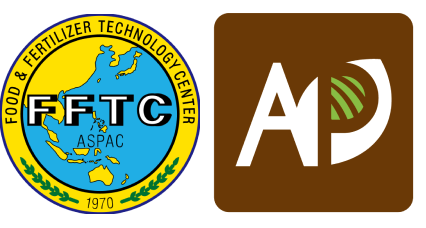

Advancing Global Food Security through Waste-to-Fertilizer Technology: Enhancing Nutrient Recovery for Fertilizer Production
ABSTRACT
Global food security is a critical issue, further intensified by population growth, climate change, and the depletion of natural resources. Sustainable agriculture offers a promising solution particularly through the enhancement of nutrient recovery for fertilizer production. This study examines the intersection of sustainable agriculture and global food security, focusing on the vital role of nutrient recovery in improving soil health, boosting crop yields, and minimizing environmental impacts. This paper provides an overview of the challenges to global food security and underscores the need for sustainable agricultural practices to address these challenges. It emphasizes the potential of recovering nutrients from waste streams, such as food waste, and wastewater to produce fertilizers. Key findings suggest that nutrient recovery could reduce reliance on synthetic fertilizers by up to 30%, improve soil nutrient content by 20-40%, and increase crop yields by 10-15%. These results highlight the significant benefits of incorporating nutrient recovery technologies into agricultural systems.
Keywords: Fertilizer production, Food security; Nutrient recovery; Sustainable agriculture; Organic waste
INTRODUCTION
The global food crisis is currently one of the urgent threats facing the world. A key challenge today is how to feed a rapidly growing population while ensuring a sustainable resource base to meet their needs. The world’s population is projected to reach 9.7 billion by 2050 (Sniatala et al., 2022), a one-third of increase from the total population in 2010. To ensure food security amid climate change, which threatens agricultural production systems, food production must increase by 70% in 2050 (Figure 1). While global food production has tripled over the past several decades, rising from 3.3 million metric tons in 1970 to 10 million metric tons today (Kurniawan et al., 2021a), this growth has been driven by population growth and increased consumption.
With the global population expected to reach 10 billion by 2050, food production must increase significantly to meet demand. The rapid population growth over recent decades has heightened awareness of food security issues. Although food systems are producing more food and calories as ever before, global crop diversity and dietary variety are steadily declining. This trend has made both the environment and food production more vulnerable to climatic shocks, with adverse effects on human nutrition and health. Rising food and fuel prices are also making healthy diets less affordable, particularly for marginalized communities. Furthermore, rapid urbanization, population growth, and rising incomes in emerging economies are reshaping both local and global food systems, leading to increased demand for affordable and safe food in urban areas (Kurniawan et al., 2021b). Addressing this dual challenge requires innovative strategies to sustain food production without further depleting natural resources.
In response to these challenges, there is growing emphasis on enhancing nutrient recovery from organic waste streams and incorporating recovered nutrients into fertilizer production. Fertilizers play a pivotal role in modern agriculture, boosting crop yields by replenishing essential nutrients such as nitrogen (N), phosphorus (P), and potassium (K). However, conventional fertilizer production faces critical challenges. A circular bioeconomy could provide a pathway of fertilizer production for developing sustainable agriculture and food systems through nutrient recovery. This approach involves extracting valuable nutrients from agricultural residues, food waste, and wastewater, and transforming them into effective, eco-friendly fertilizers (Figure 2). Such practices not only address waste management challenges but also promote a biocircular economy, where nutrients are recycled and reused, reducing reliance on finite natural resources (Kurniawan et al., 2022).
Phosphorus, for example, is derived primarily from phosphate rock, a non-renewable resource concentrated in a few countries, raising concerns over long-term availability and geopolitical risks. Simultaneously, nitrogen fertilizer production is heavily dependent on energy-intensive processes that contribute to greenhouse gas emissions. These factors highlight the urgent need for sustainable alternatives to ensure nutrient availability for future generations.
Ironically, while global agriculture grapples with nutrient scarcity, vast amounts of nutrients are lost each year through organic waste streams. Food waste, agricultural residues, sewage sludge, and even cigarette butts contain recoverable quantities of N, P, and K, yet much of this waste ends up in landfills or incinerators, contributing to pollution and greenhouse gas emissions. The mismanagement of organic waste represents a missed opportunity to recover valuable resources and mitigate environmental harm.
Currently, as the global food markets are growing swiftly, driven by the demand for bio-based supplements and therapeutic products, such high demand has posed challenges in the availability of the bioresources and downstream processing technology to produce high quality products (Figure 3). The alarming situation related to global food supply chains and wastes calls for urgent solutions for bioresource recovery to close the loops, creating a circular bioeconomy.
In this context, waste-to-fertilizer technologies have emerged as a promising solution to bridge the gap between nutrient demand and supply. These technologies leverage advanced processes, such as anaerobic digestion, biochar production, and nutrient extraction, to recover nutrients from waste materials and convert them into high-quality fertilizers. Beyond their environmental benefits, these methods align with circular economy principles, transforming waste into a resource and reducing dependence on non-renewable inputs.
It is expected that the world can make a key difference in this global environmental change through circular bioeconomy in the form of waste-to-fertilizer technologies. To exercise climate leadership, it is important for cities to promote transition that provides leverage to curb the consumption of raw material from natural resources through circular economy of materials disposed in landfills (Figure 4) ( Osman et al., 2025; Panda et al., 2024; Pathak et al., 2022). Recovering nutrients embedded in wastewater is an opportunity to transition to biocircular economy and contribute to sustainable agriculture and food systems.
One of the most pressing consequences of this geopolitical crisis is the severe shortage of fertilizers, a critical input for modern agriculture. This shortage threatens to exacerbate existing challenges in global food production, potentially leading to a looming food security crisis. The fertilizer shortage caused by the Russian-Ukraine war has far-reaching implications for global food security. The disruption in fertilizer supply contributes to rising food prices, which can strain household budgets and increase food insecurity in low-income and developing regions. Declining crop yields and higher food prices can lead to increased hunger and malnutrition in vulnerable populations already at risk. The interconnected nature of global food supply chains results in disruptions in one region, leading to cascading effects worldwide. Countries dependent on imports of fertilizers and food may therefore face shortages and price volatility.
To mitigate the impact of fertilizer shortages and ensure global food security, several strategies are essential. Reducing reliance on a few major fertilizer producers and exploring alternative sources can help stabilize supply chains and reduce vulnerability to geopolitical disruptions. Encouraging the adoption of sustainable agriculture practices, such as nutrient recycling and organic farming, can reduce dependency on synthetic fertilizers and improve resilience.
Nutrient recovery optimizes the use of available resources by recycling nutrients from food waste, livestock manure, and liquid wastewater from landfill (Figure 5). This reduces dependency on non-renewable resources, such as phosphates and fossil fuels, and promotes a circular economy in agriculture. Nutrient recovery not only provides an alternative source of fertilizers but also improves soil health by restoring essential nutrients. Healthy soils are more productive and resilient, leading to better crop performance and long-term sustainability of agricultural systems. Implementing nutrient recovery technologies can create economic opportunities, particularly in rural and agricultural communities. This approach can also make fertilizers more accessible and affordable for smallholder farmers, promoting more equitable and inclusive agricultural development.
Sustainable nutrient recovery practices also improve soil health by replenishing essential nutrients, leading to better crop yields and more resilient agricultural systems. This is crucial for long-term food production and the sustainability of farming practices. By enhancing nutrient recovery from waste streams, this work advocates for more sustainable practices that reduce the environmental footprint of agriculture, helping to conserve natural resources and mitigate climate change.
To reflect its novelty, this work explores the pivotal role of nutrient recovery in advancing sustainable agriculture and enhancing global food security. At the same time, it examines practices for recovering nutrients and their application in agriculture. This work presents a comprehensive framework that links nutrient recovery from various waste streams directly to global food security. While nutrient recovery and sustainable agriculture have been studied separately, this work uniquely integrates them, demonstrating how they can synergistically address food security challenges on a global scale. By addressing critical gaps in current waste management and nutrient recovery practices, this work offers a pathway to sustainable fertilizer production and contributes to global efforts to secure food for future generations.
The work also emphasizes the application of circular economy principles in agriculture by promoting the recycling of nutrients from food waste, livestock manure, and wastewater into fertilizers. This approach is innovative as it shifts the paradigm from linear resource use to a closed-loop system, reducing waste and enhancing resource efficiency in agriculture. The study also explores how sustainable agricultural practices through nutrient recovery can boost crop yields and ensure a stable food supply, making it crucial for global food security. The work aligns with the principles of a circular economy, where waste materials are repurposed and reintegrated into the production cycle. This reduces waste, conserves resources, and creates more sustainable agricultural practices.
The objectives of this study are to evaluate the effectiveness of nutrient recovery technologies, assess their potential benefits for soil fertility and crop yields, and explore their contributions to a more sustainable and resilient agricultural system. By highlighting key findings and advancements in nutrient recovery, this work aims to provide insights into how the practices can support global food security and drive the transition towards sustainable agricultural practices. Through a comprehensive review of current methods and their applications, the study offers recommendations for integrating nutrient recovery into agricultural systems and policy frameworks, contributing to a more sustainable and food-secure future.
By demonstrating the benefits of nutrient recovery, this work highlights the need for supportive policies and economic incentives to promote the practices, while underscoring the necessity of advancing waste-to-fertilizer technologies to address the interrelated challenges of food security, resource scarcity, and environmental sustainability. Through the innovative use of waste materials and cutting-edge adsorption techniques, the study provides a foundation for scalable and sustainable solutions to meet the nutrient demands of a growing global population. By focusing on nutrient recovery, this work supports the reduction of waste associated with conventional fertilizer production and use. This contributes to efforts to combat climate change, reduce GHG emission, and protect natural ecosystem.
KNOWLEDGE GAPS
Although this work addresses critical areas, there are still knowledge gaps that need to be explored to fully realize the potential of nutrient recovery and sustainable agriculture. While nutrient recovery is known to enhance soil fertility, there is limited long-term data on how these practices affect the overall soil health, biodiversity, and ecosystem services over extended periods. Therefore, longitudinal studies are needed to monitor the effects of nutrient recovery on soil microbial communities, soil structure, and ecosystem services such as water retention and carbon sequestration. Understanding the long-term impacts can refine nutrient recovery practices to maximize their benefits.
CONTRIBUTION TO UN SDGs
The work makes significant contributions to several United Nations Sustainable Development Goals (UN SDGs). The primary focus of the work is on enhancing global food security, which directly contributes to SDG#2 ‘Zero Hunger’. By promoting sustainable agriculture and nutrient recovery for fertilizer production, the work aims to increase agricultural productivity, improve soil health, and boost crop yields. This helps ensure a reliable food supply, particularly in regions facing food insecurity, ultimately working towards the goal of ending hunger and achieving food security.
The emphasis on nutrient recovery from waste streams aligns with SDG#12 ‘Responsible Consumption and Production’ by promoting sustainable consumption and production patterns. The work advocates for a circular economy in agriculture, where waste materials such as food waste, livestock manure, and wastewater are recycled into valuable fertilizers (Figure 6). By diverting waste from landfills and recovering nutrients, waste-to-fertilizer initiatives can reduce greenhouse gas emissions, alleviate nutrient pollution, and support resilient agricultural systems. This reduces waste, conserves resources, and promotes more efficient and responsible use of natural resources.
By reducing reliance on synthetic fertilizers, which are energy-intensive and contribute to GHG emissions, the work supports SDG#13 ‘Climate Action’. Nutrient recovery and sustainable agricultural practices help mitigate climate change by lowering the carbon footprint of food production and reducing environmental pollution. Additionally, healthier soils sequester more carbon, further contributing to climate action. Overall, this work contributes to UN SDGs by addressing food security, promoting sustainable resource management, mitigating climate change, protecting ecosystems, and fostering economic development through the advancement of sustainable agricultural practices.
CASE STUDIES: TAKAKURA HOME COMPOSTING (THC) METHOD
THC, developed by Dr. Koji Takakura (Japan), is a method of composting organic waste in a controlled, simple, and effective manner. This method has significant contributions to agricultural farming as a fertilizer. THC produces high-quality compost rich in essential nutrients such as N, P, and K (Figure 7). These nutrients are crucial for plant growth and soil health. By incorporating this compost into the soil, farmers can enhance soil fertility and improve crop yields. The compost adds organic matter to the soil, which improves soil structure, water-holding capacity, and aeration. This helps create a favorable environment for root development and beneficial soil microorganisms.
Takakura composting promotes the growth of beneficial microorganisms in the compost. When applied to the soil, these microorganisms enhance soil biological activity, which contributes to nutrient cycling and the overall health of the soil ecosystem. The compost can help suppress soil-borne diseases and pests by enhancing the microbial diversity and activity in the soil. Healthy soil with a balanced microbial community is more resilient to disease outbreaks. By using Takakura compost as a natural fertilizer, farmers can reduce their reliance on synthetic fertilizers. This not only cuts costs but also minimizes the environmental impacts associated with the production and application of chemical fertilizers. Incorporating compost into farming practices promotes sustainable fertility management. It helps close the nutrient loop by recycling organic waste into valuable soil amendments, reducing the need for external inputs.
The organic matter in Takakura compost helps improve soil structure by promoting the formation of soil aggregates. Better soil structure enhances root penetration and reduces soil compaction. Compost increases the soil’s ability to retain water, which is particularly beneficial during dry periods. Improved water retention helps maintain consistent soil moisture levels, reducing the need for frequent irrigation.
THC provides an effective solution for managing organic waste at the household level. By recycling kitchen scraps, garden waste, and other organic materials, it reduces the volume of waste sent to landfills. The composting process produces fewer greenhouse gases compared to landfill decomposition. By turning organic waste into compost, the method helps mitigate climate change by reducing methane emissions.
The Takakura composting method is simple and cost-effective, making it accessible for small-scale and local farmers. It allows them to produce high-quality compost with minimal investment, supporting local food production. In community and urban farming settings, Takakura composting can be used to create nutrient-rich soil amendments for shared garden plots and urban agriculture projects, enhancing food security and community resilience.
The use of Takakura composting in agriculture raises awareness about sustainable waste management and organic farming practices. It serves as an educational tool for promoting environmental stewardship and responsible resource use. Overall, THC contributes to agricultural farming by providing a nutrient-rich, organic fertilizer that enhances soil fertility and health, reduces reliance on synthetic fertilizers, improves soil structure and water retention, and supports sustainable waste management practices. Its simplicity and effectiveness make it a valuable tool for both small-scale and larger agricultural operations.
CASE STUDIES: BOKASHI HOME COMPOSITNG (BHC) METHOD
Bokashi home composting is an innovative approach to managing household organic waste, drawing from traditional Japanese practices. Unlike conventional composting methods, which rely on the presence of oxygen to break down organic matter, Bokashi uses an anaerobic process, meaning it occurs in the absence of oxygen. This process leverages a special mix of microorganisms to ferment, rather than decompose, the waste (Figure 8).
The journey begins with the preparation of a Bokashi bin, an airtight container equipped with a spigot for draining liquid. The process also requires Bokashi bran, which is inoculated with beneficial microorganisms such as lactic acid bacteria, yeasts, and phototrophic bacteria. As organic waste, including vegetable scraps, coffee grounds, and even small amounts of meat or dairy, is added to the bin, it is layered with the Bokashi bran. This layering continues until the bin is full.
Once the bin is sealed, the fermentation phase begins. For approximately two weeks, the microorganisms work to ferment the waste in the oxygen-free environment, producing a pickled, semi-decomposed material. During this period, the bin is stored in a cool, dark place to maintain the right conditions for fermentation.
An interesting byproduct of this process is the liquid known as "Bokashi tea." This nutrient-rich liquid is drained regularly and can be diluted with water to serve as a powerful fertilizer or even as a natural drain cleaner. After the two-week fermentation, the contents of the Bokashi bin are ready for the final stage. The fermented material can be buried directly in the soil or added to a traditional compost pile, where it will decompose rapidly and enrich the soil.
Bokashi composting stands out for its versatility and efficiency. Unlike traditional composting, it can handle a broader range of organic waste, including items like meat and dairy that are typically avoided due to odor and pest concerns. Its space-efficient design makes it particularly suitable for urban environments, where space may be limited. Moreover, the process is relatively quick, and the airtight containers used in Bokashi composting help to eliminate any unpleasant odors.
One of the key benefits of this method is that it preserves more nutrients in the composted material, which can be extremely beneficial for soil health. This makes Bokashi composting an attractive option for those looking to reduce household waste and enrich their gardens, even in small urban settings.
In comparison to other methods, such as the Takakura Home Composting (THC) method, which relies on aerobic decomposition, Bokashi offers a more controlled and efficient process, albeit with the added step of acquiring or preparing Bokashi bran. The choice between these methods may depend on individual preferences and specific household needs.
BENEFITS OF THIS WORK
The expected results of the work encompass a range of outcomes aimed at improving food security, advancing sustainable agriculture, and promoting environmental sustainability. Development and optimization of technologies for more efficient recovery of nutrients from waste streams, such as agricultural residues, food waste, and wastewater lead to a higher quality and quantity of recovered nutrients available for use in fertilizers. Better management practices that minimize nutrient losses during fertilizer application result in more effective use of nutrients and improved crop productivity (Batool et al., 2023).
Application of recovered nutrients from sludge improves soil fertility by adding essential nutrients and organic matter (Figure 8). This will lead to better soil structure, water retention, and microbial activity. With improved soil conditions and more efficient nutrient use, farmers can expect increased crop yields and better quality produce. This contributes to enhanced food security and agricultural productivity.
A shift towards using recovered nutrients will decrease the reliance on synthetic fertilizers, which are resource-intensive and environmentally taxing to produce. By minimizing the need for synthetic fertilizers and effectively managing organic waste, the work will contribute to reduced greenhouse gas emissions and lower environmental pollution. Farmers and agricultural producers may experience cost savings due to reduced expenditure on synthetic fertilizers and improved efficiency in nutrient use. Development and commercialization of nutrient recovery technologies can stimulate economic growth and create job opportunities in waste management and agricultural sectors (Kurniawan et al., 2023b).
SYNERGY AMONG TECHNOLOGICAL AND POLICY IMPLEMENTATION
Advancing global food security through sustainable agriculture while enhancing nutrient recovery for fertilizer production involves a multi-faceted approach that integrates technology, policy, education, and collaboration. To promote efficient nutrient recovery technologies, it is necessary to invest in research and development to improve nutrient recovery technologies, such as anaerobic digestion, composting, and nutrient extraction from wastewater, while focusing on making these technologies more efficient, cost-effective, and scalable.
It is crucial to implement pilot projects to test and showcase the effectiveness of nutrient recovery technologies in various agricultural settings. The demonstrations can help validate technologies and encourage broader adoption. To integrate nutrient recovery into agricultural practices, it is necessary to use precision agriculture techniques to optimize nutrient application, reduce waste, and improve the efficiency of recovered nutrients. Technologies like soil sensors and variable-rate application systems can enhance nutrient management.
Additionally, it is necessary to promote the integration of nutrient recovery within circular agricultural systems where organic waste, such as crop residues and manure, is recycled into valuable fertilizers, closing the nutrient loop. To enhance Soil Health and Fertility, it is vital to use recovered nutrients to enhance soil fertility and structure, which can lead to increased crop yields and resilience. Practices like cover cropping, reduced tillage, and organic amendments contribute to sustainable soil health. It is necessary to continuously monitor soil health and nutrient levels to adjust practices and ensure optimal use of recovered nutrients, maintaining soil fertility and preventing over-application.
By implementing these strategies, it is possible to advance global food security while enhancing nutrient recovery for fertilizer production. This integrated approach will contribute to sustainable agricultural practices, improved soil health, and a more resilient food system (Al-Hazmi et al., 2024).
NAVIGATING THE FUTURE: PROMOTING FOOD SECURITY THROUGH SUSTAINABLE AGRICULTURE
The journey towards enhancing global food security through sustainable agriculture, particularly via nutrient recovery for fertilizer production, represents a pivotal and multifaceted endeavor. To fully realize the potential of this work and ensure its lasting impact, several strategic pathways must be pursued.
Scaling up implementation is crucial for translating research into real-world benefits. Pilot programs are essential for testing nutrient recovery technologies in diverse agricultural settings, providing insights into their viability and effectiveness. By tailoring the solutions to regional contexts, those facing acute food security challenges, we can optimize their impact and foster broader adoption.
Enhancing research and development (R&D) will drive the innovation needed to advance nutrient recovery technologies. Investing in R&D to improve the efficiency, affordability, and environmental sustainability of these technologies is vital. Interdisciplinary research that integrates agronomy, environmental science, and economics will yield a more comprehensive understanding of nutrient recovery’s impacts and opportunities (Premakumara et al., 2014).
By pursuing these strategic pathways, we can advance the implementation of nutrient recovery in agriculture, ultimately contributing to global food security, environmental sustainability, and economic development. The collective effort of stakeholders across sectors is essential in realizing the full potential of this transformative work (Batool et al., 2024).
CONCLUSION
The challenges and opportunities in the fertilizer industry reflect broader global efforts to enhance sustainability and resilience in the global economy. This work highlights the complex interplay of geopolitics, decarbonization, and food security, underscoring the evolving geopolitical implications of these interconnected factors. This dynamic landscape calls for a research agenda that addresses the factors reshaping the industry. Whether green industrialization can offer a viable solution remains an intriguing question for the future. Understanding the complexities of the path forward is forging a new approach that both protects and ensures food security for future generations.
The study emphasizes the critical role of efficient nutrient recovery in achieving global food security and advancing sustainable agricultural practices. Through a comprehensive exploration of nutrient recovery technologies and their applications, the study offers insights and key findings that are essential for shaping future agricultural strategies.
The shift towards using recovered nutrients supports sustainable fertilizer production by reducing reliance on resource-intensive synthetic fertilizers. This transition contributes to a lower environmental footprint and supports circular economy principles. The economic advantages of using recovered nutrients include cost savings on synthetic fertilizers and potential economic growth in the nutrient recovery sector. Environmentally, the reduction in greenhouse gas emissions and improved waste management practices contribute to a more sustainable agricultural system.
This work emphasizes that effective nutrient recovery and management are crucial for enhancing global food security. By improving agricultural productivity and resilience, these practices address food security challenges and support the stability of food systems worldwide. The findings provide valuable evidence to inform policy development and regulatory frameworks, promoting the adoption of nutrient recovery practices. Additionally, the study highlights the need for increased education and awareness to facilitate the widespread implementation of sustainable practices.
Overall, this work presents a transformative approach to addressing critical challenges in agriculture and food security. The integration of advanced nutrient recovery technologies, coupled with improved soil management and sustainable practices, paves the way for a more resilient and efficient agricultural system. The key findings underscore the potential for significant economic, environmental, and social benefits, positioning nutrient recovery as a vital component in advancing global food security and promoting sustainable agricultural development.
REFERENCES
Al-Hazmi, H.E., Hassan, G.K., Kurniawan, T.A., Sniatala, B., Joseph, T.M., Majtacz, J., Piechota, G., Li, X., El-Ghary, F.A., Saeb, M.R., & Makinia, J. 2024. Technological solutions to landfill management: Contribution toward recovery of biomethane and carbon neutrality. J. Environ. Manage. 354, 120414. doi: 10.1016/j.jenvman.2024.120414
Batool, F., Kurniawan, T.A., Mohyuddin, A., Othman, M.H.D., Goh, H.H., Anouzla, A., & Chew, K.W. 2023. Fixed bed studies of landfill leachate treatment using chitosan-coated carbon composite. Water 15, 2263. doi: 10.3390/w15122263
Batool, F., Kurniawan, T.A., Mohyuddin, A., Othman, M.H.D., Aziz, F., Al-Hazmi, H., Goh, H.H., & Anouzla, A. 2024. Environmental impacts of food waste management technologies: A critical review of life cycle assessment (LCA) studies. Trend in Food Sci. Technol. 143, 104287. doi: 10.1016/j.tifs.2023.104287
Kurniawan, T.A., Oliveira, J.P., Gamaralalage, P.J.D., & Nagaishi, M. 2013. City-to-city level cooperation for generating urban co-benefits: The case of technological cooperation in the waste sector between Surabaya (Indonesia) and Kitakyushu (Japan). J. Clean. Prod. 58, 43–50. doi: 10.1016/j.jclepro.2013. 08.002.
Kurniawan, T.A., Avtar, R., Singh, D., Xue, W., Dzarfan Othman, M.H., Hwang, G.H., Iswanto, I., Albadarin, A.B., & Kern, A.O. 2021a. Reforming MSWM in Sukunan (Yogjakarta, Indonesia): A case-study of applying a zero-waste approach based on circular economy paradigm. J. Clean. Prod. 2020, 124775. doi:10.1016/j.jclepro.2020.124775.
Kurniawan, T.A., Singh, D., Avtar, R., Dzarfan Othman, M.H., Hwang, G.H., Albadarin, A.B., Rezakazemi, M., Setiadi, T., & Shirazian, S. 2021b. Resource recovery from landfill leachate: An experimental investigation and perspectives. Chemosphere 274, 129986. doi: 10.1016/ j.chemosphere.2021. 1299.
Kurniawan, T.A., Singh, D., Xue, W., Avtar, R., Othman, M.H.D., Hwang, G.H., Setiadi, T., Albadarin, A.B., & Shirazian, S. 2021c. Resource recovery toward sustainability through nutrient removal from landfill leachate. J. Environ. Manag. 2021, 287, 112265. doi: 10.1016/j.jenvman. 2021.112265.
Kurniawan, T.A., Liang, X., Singh, D., Othman, M.H.D., Goh, H.H., Gikas, P., Kern, A.O., Kusworo, T.D., & Shoqeir, J.A. 2022. Harnessing landfill gas (LFG) for electricity: A strategy to mitigate greenhouse gas emissions in Jakarta (Indonesia). J. Environ. Manag. 301, 113882. doi: 10.1016/j.jenvman. 2021.113882.
Kurniawan, T.A., Othman, M.H.D., Liang, X., Ayub, M., Goh, H.H., Kusworo, T.D.K., Mohyuddin, A., & Chew, K.W. 2023a. Microbial fuel cells (MFC): A potential game-changer in renewable energy development. Sustainability 4, 16847. doi: 10.3390/su142416847
Kurniawan, T.A., Othman, M.H.D., Liang, X., Goh, H.H., & Chew, K.W. 2023b. From liquid waste to mineral fertilizer: Recovery, recycle and reuse of high-value macro-nutrients from landfill leachate to contribute to circular economy, food security, and carbon neutrality. Proc. Saf. Environ. Prot. 170, 791-807. doi: 10.1016/j.psep.2022.12.068
Kurniawan, T.A., Othman, M.H.D., Goh, H.H., Gikas, P., Kusworo, T.D., A. Anouzla, & Chew, K.W. 2023c. Decarbonization in waste recycling industry using digital technologies to contribute to carbon neutrality and its implications on sustainability. J. Environ. Manage. 338, 117765. doi: 10.1016/j.jenvman.2023.117765
Kurniawan, T.A., Liang, X., Goh, H.H., Othman, M.H.D., Anouzla, A., Aziz, F., Chew, K.W., & Ali, I. 2024a. Leveraging food waste for electricity: A low carbon approach in energy sector for mitigating climate change and achieving carbon neutrality in Hong Kong (China). J. Environ. Manage. 351, 119879. doi: 10.1016/j.jenvman.2023.119879
Kurniawan, T.A., Bandala, E.R., Othman, M.H.D., Goh, H.H., Anouzla, A., Chew, K.W., Aziz, F., Al-Hazmi, H., & Khoir, A.N. 2024b. Implications of climate change on water quality and sanitation in climate hotspot locations: A case-study from Indonesia. Water Supply 24, 517–542. doi: 10.2166/ ws.2024.008
Osman, A.I., Nasr, M., Aniagor, C.O. et al. 2025. Synergistic technologies for a circular economy: upcycling waste plastics and biomass. Front. Chem. Sci. Eng. 19, 2. doi: 10.1007/s11705-024-2507-0
Panda, U. 2024. Circular Economy: A Systematic Paradigm for Transition from ‘Soil to Silver’ toward a Sustainable Future. Circ.Econ.Sust. doi: 10.1007/s43615-024-00471-6
Pathak, P., & Palani, S. G. (Eds.). 2022. Circular economy in municipal solid waste landfilling: biomining & leachate treatment: Sustainable solid waste management. In: Waste to Wealth. Springer Nature. doi: 10.1007/978-3-031-07785-2Premakumara, D.G.J., Canete, A.L.M.L., Nagaishi, M., & Kurniawan, T.A. 2014. Policy implementation of the Republic Act (RA) No. 9003 in the Philippines on MSW management: A case study of Cebu City. Waste Management 34, 971-979. doi: 10.1016/j.wasman.2013. 10.040
Sniatala, B, Kurniawan, T.A., Sobotka, D., Makinia, J., & Othman, M.H.D. 2022. Macro-nutrients recovery from wastewater as a sustainable resource for synthetic fertilizer: Uncovering alternative options to promote global food security cost-effectively. Sci. Total Environ. 856, 159283. doi: 10.1016/j.scitotenv.2022.159283